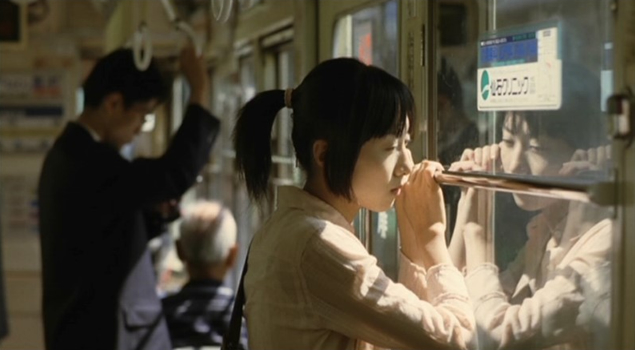
Taiwan’s Hsiao-hsien Hou has often spoken of his admiration for Japanese master Yasujirō Ozu. In the 1993 documentary Talking with Ozu, attached to the Criterion edition of Tokyo Story and featuring such commentators as Claire Denis and Aki Kaurismäki, he compares the man’s work to that of a mathematician: one that observes and studies in a detached, clinical fashion. Often, returning to the same themes of generational conflict within the family unit, but doing so with a profound self-confidence that only lends such reiterations more weight. Hou goes on to state that, while he considers his own “observations and insight into the human condition” to be similarly objective, he really can’t compare. Yet, the similarities are very much evident. Indeed, few batted an eyelid when Ozu’s longtime employer Shochiku, upon commissioning a project for his centenary, chose not a Japanese but Taiwanese director to best capture the spirit of his films. The result is Café Lumière, Hou’s first venture beyond his native country.
Like a serene pastoral image of saturated greens and browns torn violently asunder by bold lines of steel and iron, the railroad is a prominent feature upon the cinematic landscapes of both Ozu and Hou. In Tokyo Story for example, it represents the clanging onset of modernity in the lives of all those it casts in shadow; an encroaching harbinger of westernisation that that erodes traditional family values and structure, replacing them with a younger generation that embraces individualisation and materialism. Indeed, it is the train that dominates only the third image witnessed in Tokyo Story: an endless line of impassive black coaches that pass from left to right as the film opens, splitting a tree-lined valley and seemingly surfing on the tops of clustered and cowering houses. Trains arriving and departing are a recurring Ozu image, perhaps suggesting some kind of transience: that life is but a fleeting thing, and the only evidence of its existence can be read in the smoke it leaves behind.

Trains can be seen as a prominent visual element in contemporary Asian cinema in general, especially recently. Consider for a moment the work of Korean auteur Lee Chang-dong: the mysterious woman that evocatively leans out of a train carriage window in Green Fish, her lost scarf fluttering back to envelope the camera; or the ultimate outpouring of emotion that occurs on a railway bridge in Peppermint Candy, when a character reaches rock bottom and an onrushing train represents some kind of escape. And Lee’s compatriot, Bong Joon-ho: grappling silhouettes in the mouth of a tunnel in Memories of Murder – not to mention the eponymous presence of the train in his first English language feature, where locomotive and narrative run side by side. Another creative use of trains and tracks can be found in Katsuhito Ishii’s The Taste of Tea which sees a narrowly missed passenger train subsequently burst forth in miniature form from a young boy’s head, as though departing with his hopes and dreams.
Hou has often employed trains in a symbolic manner: the arrival and departure of one bookends The Green, Green Grass of Home; a train journey can be seen as emblematic of generational progression in A Summer at Grandpa’s; then we become the train itself in Dust in the Wind, slowly chugging forward in first person perspective. The trains that appear in Hou’s later works are not steaming, pumping machines but streamlined examples of perfect engineering. In Café Lumière (and to a lesser extent Flight of the Red Ballon) they enclose figures in an almost embryonic casing – as is suggested by the vector illustration that Hajime (Tadanobu Asano) creates, and the foetal position that Yôko (Yo Hitoto) assumes trackside at one point. Her train rides represent some kind of internal intimacy; for him, it is the sights and sounds of the station that become so evocative. The experience is a sensory one, much like that of the French spectators who famously fainted upon witnessing The Arrival of a Train, made in 1896 by the Lumière brothers from whose name Hou’s title is derived.
Perhaps the most iconic compositional tool in Ozu’s arsenal was always his famed Tatami Shot, with the static camera placed at waist height so as to bring the audience down to the same level of his subjects. Hou purports a direct homage to this in Café Lumière, borrowing the format to deftly frame Yôko’s return to her parents’ house; the creaking wooden floors and engulfing silence of the home in which she grew up. A more specific reference arrives later, when Yôko borrows saké from a neighbour – recalling a similar scene in Tokyo Story. Everywhere you look there are keen nods in the direction of Ozu: even the narrative itself, with the young woman who finds herself pregnant out of wedlock and must break the news to her parents. Yet, despite all these thematic parallels there remains a considerable distance between Hou’s approach and that of Ozu, at least stylistically: perhaps foremostly the average shot length of each, which differs vastly. Hou’s long takes push his average to well over a minute, whereas Ozu’s is almost a third of that. The one element that maintains the status of Café Lumière, while a tribute to Ozu, as a film unique to Hou.


